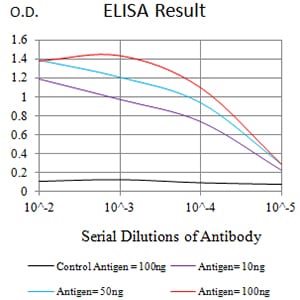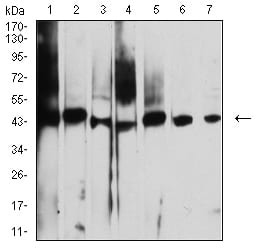

| WB | 1/500 - 1/2000 | Human,Mouse,Rat |
| IF | 咨询技术 | Human,Mouse,Rat |
| IHC | 咨询技术 | Human,Mouse,Rat |
| ICC | 技术咨询 | Human,Mouse,Rat |
| FCM | 咨询技术 | Human,Mouse,Rat |
| Elisa | 1/10000 | Human,Mouse,Rat |
| Entrez GeneID | 550 |
| clone | 1H6A1 |
| WB Predicted band size | 53kDa |
| Host/Isotype | Mouse IgG2b |
| Antibody Type | Primary antibody |
| Storage | Store at 4°C short term. Aliquot and store at -20°C long term. Avoid freeze/thaw cycles. |
| Species Reactivity | Human,Mouse |
| Immunogen | Purified recombinant fragment of human AUP1 (AA: 229-410) expressed in E. Coli. |
| Formulation | Purified antibody in PBS with 0.05% sodium azide |
+ +
以下是关于AUP1抗体的3篇参考文献,按研究背景简要概括:
1. **文献名称**:*AUP1 regulates the ERAD degradation pathway by binding to E2 ubiquitin-conjugating enzymes*
**作者**:Hirsch C et al.
**摘要**:研究利用AUP1抗体(免疫印迹和免疫荧光)揭示了AUP1在内质网相关降解(ERAD)中的作用,证明其通过与E2泛素结合酶互作促进底物泛素化。
2. **文献名称**:*The lipid droplet protein AUP1 coordinates hepatic lipoprotein assembly and secretion*
**作者**:Suzuki M et al.
**摘要**:通过AUP1抗体(免疫组化)发现AUP1在肝细胞脂滴中富集,调控极低密度脂蛋白(VLDL)组装,缺失导致小鼠血脂代谢异常。
3. **文献名称**:*AUP1 bridges the gap between lipid droplets and the endoplasmic reticulum in peroxisome biogenesis*
**作者**:Schrul B et al.
**摘要**:使用AUP1抗体(共聚焦成像)证实AUP1连接脂滴与内质网,参与过氧化物酶体生成,其缺失导致细胞器形态异常和功能受损。
**注**:若需具体实验细节(如抗体货号、应用场景),建议补充筛选条件或结合最新数据库(如CiteAb)检索。
The AUP1 (Ancient Ubiquitous Protein 1) antibody is a tool used to study the AUP1 protein, a multifunctional enzyme involved in cellular processes such as endoplasmic reticulum (ER)-associated degradation (ERAD), lipid droplet regulation, and autophagy. AUP1 contains a ubiquitin-binding UBX domain and a conserved LC3-interacting region, enabling its role in bridging ubiquitination and autophagic machinery. It localizes to the ER and lipid droplets, where it interacts with proteins like UBXD8 and GABARAP to mediate lipid homeostasis or target misfolded proteins for proteasomal degradation.
AUP1 antibodies are widely employed in research to investigate its expression, subcellular localization, and interactions. They are used in techniques like Western blotting, immunofluorescence, and immunoprecipitation. Dysregulation of AUP1 has been linked to metabolic disorders, neurodegenerative diseases, and cancers, making its antibody a critical reagent for exploring disease mechanisms. Commercial AUP1 antibodies are typically raised against specific epitopes (e.g., human AUP1 amino acids 100-200) and validated for cross-reactivity in various species (human, mouse, rat). Recent studies highlight AUP1's role in viral infection pathways, further underscoring its biomedical relevance. Proper controls, such as knockout cell lines, are recommended to confirm antibody specificity due to potential cross-reactivity with structurally similar proteins.
×